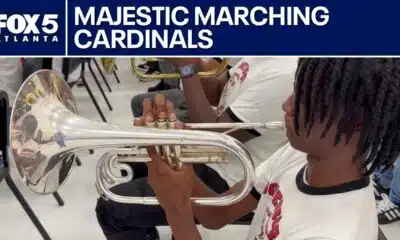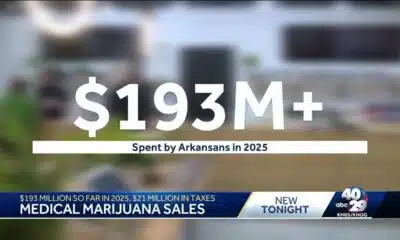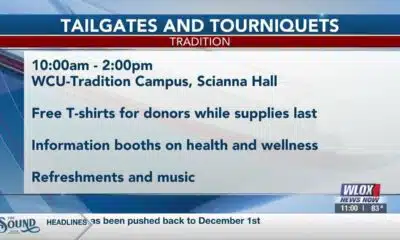News from the South - Arkansas News Feed
Research into biodegradable plastics involves Arkansas scientist
by John Lovett, Special to the Advocate, Arkansas Advocate
April 28, 2025
FAYETTEVILLE, Ark. — While biodegradable plastics currently account for a half percent of the hundreds of millions of tons of plastic produced annually, a growing demand for the alternative reflects consumer awareness and corporate response.
Researchers from Brazil, Germany and the United States document a multi-faceted global snapshot of the environmental aspects and trends surrounding single-use plastics in a review article titled “Rethinking single-use plastics: Innovations, policies, consumer awareness and market shaping biodegradable plastics in the packaging industry.” The piece was recently published in Trends in Food Science & Technology.
The researchers state that the largest area of application for biodegradable plastic materials is the packaging segment, which accounts for about half of single-use plastic production. The biodegradable packaging market was estimated to reach about $105 billion in 2024 with an expected annual growth rate of about 6 percent between 2024 and 2029, and 44 percent of patents filed worldwide for biodegradable polymers relate to packaging, the study noted.
About 474 million tons of plastics are produced globally each year, and about a third of it is used for packaging, including single-use plastic products for food and beverage containers. Of this, only about 25 percent gets recycled. Plastic production, the article adds, is expected to triple by 2060 following a trend of transitioning from durable plastics to single-use plastics.
Global plastic production increased from 369 million tons in 2016 to 404.5 million tons in 2020, partly due to materials used in the COVID-19 pandemic.
Citing a 2021 study from the same research group in Brazil, the review article noted the pandemic “exacerbated the use of single-use plastic and increased the demand for personal protective equipment and packaging, leading to remarkable growth in the plastics industry and generating more than 8 million tons of waste, mainly affecting Asia, Europe and America.” The same study mentions that the pandemic expanded food packaging due to a shift in eating habits and an increase in online purchases.
Despite the transition to single-use plastics, an increasing number of patents and successful research and development of biodegradable plastic materials has sparked the interest of industries to invest in large-scale production technologies for renewable monomers and polymers, the researchers added.
Looking to corn
Barone is supervised by Ana Elizabeth Cavalcante Fai, corresponding author for the review article, a food engineer and associate professor in food science at Rio de Janeiro State University, where she coordinates the Laboratory of Multidisciplinary Practices for Sustainability at the Institute of Nutrition.
“Food packaging plays a vital role in ensuring food safety and quality,” Fai said. “However, it is increasingly unjustifiable to produce short-life cycle packaging using synthetic plastics that persist in the environment for up to 400 years. Even more concerning is the growing awareness that plastics don’t degrade completely — they fragment into micro- and nanoplastics, which are now recognized as widespread environmental pollutants and an emerging public health concern.”
Ferreira said that while biodegradable plastics are a promising long-term alternative solution, it is not where he expects to see the biggest short-term impact on the reduction of overall plastic use.
Fai and Barone said that plastic has undeniably transformed modern life since its mass production began in the 1950s. However, despite its versatility and usefulness, “plastic has often been misused and is frequently applied to single-use items which are discarded with little regard for environmental consequences.”
“Most of the plastic ever made still exists in some form today,” Fai said. “When people say, ‘just throw it away,’ we must remember — there is no ‘away.’ Everything remains within the boundaries of our shared environment. The planet simply cannot absorb this volume of waste indefinitely. If current trends continue, some projections estimate that by 2050, there could be more plastic than fish in our oceans. This is not just alarming — it’s a call to urgent action.”
A “circular economy,” Ferreira said, could have a larger long-term impact on single-use plastic reduction. A circular economy broadens the familiar slogan of “reduce, reuse, recycle” to “rethink, refuse, reduce, reuse, repair and recycle,” in that order.
Brazil has an extraordinary biodiversity, Fai said, and a significant agro-industrial biomass base, rich in polysaccharides such as starch, pectin, lignin, and others. These valuable raw materials can be transformed into bio-based and biodegradable packaging for the food industry, she added.
“Through international partnerships, where each research group contributes its unique expertise, we can join efforts to develop sustainable and innovative packaging solutions,” Fai said. “This collaborative approach is key to building a more sustainable future for food systems worldwide,” said Fai and Barone.
“We are part of the problem as consumers, but at the end of the day, as consumers we can be part of the solution,” Ferreira said.
Co-authors of the review article on single-use plastics include Carollyne Maragoni-Santos of Federal University of the State of Rio de Janeiro; Patricia Marques de Farias of the Sustainable Packaging Institute in Germany; Camila Marcolongo Gomes Cortat of the Laboratory of Multidisciplinary Practices of Sustainability, Institute of Nutrition at the State University of Rio de Janeiro; Bianca Chieregato Maniglia of the University of São Paulo; and Ricardo Schmitz Ongaratto in the chemistry school at Federal University of Rio de Janeiro.
Plastics on the farm
“In our transplant production, rather than using the single-use plastics that you see in a store when you get plants, we use extra sturdy plastic transplant trays,” Friedrich said. “We know farmers who have used these for 20-plus years and are still strong.”
Friedrich said the CAFF farm also uses a paper pot system adapted from Japan that uses a chain of paper strips to form cells in which they grow the transplants. The training farm also uses a landscape fabric instead of plastic mulch for weed control, which can be reused over many years.
However, use of single-use plastic is unavoidable at times. For its “tractor-scale” production, CAFF uses the black plastic seen on strawberry beds at u-pick operations.
“Plants respond well to plasticulture because it warms the soil early, creates a weed free zone and delivers water directly to the plant roots,” Friedrich said. “The current biodegradable options for this function can’t hold up over the long, hot season.”
A thick, clear plastic is used to cover high tunnels at the farm, but that material has a longer lifespan of four to six years. High tunnels differ from greenhouses by generally having less climate control but still allow protection of plants from the elements and extend the growing season from early spring to late fall.
Irrigation drip tape — a flat tubing that provides water directly to plant roots — can also be a source of plastic on the farm, Friedrich said, and they try to use theirs for multiple years to minimize landfill deposits.
“In other areas of the state, there are recycling options that farmers can off-load their irrigation plastic,” Friedrich said.
Polypipe is commonly used for irrigation in row crop operations. When the season has ended, farmers roll up the pipe and drop it off for recycling.
The Center for Arkansas Farms and Food was developed to strengthen and expand our food and farming system by providing new opportunities to shape our current and future farmers, food entrepreneurs and food system leaders. CAFF is a program of the Arkansas Agricultural Experiment Station through the University of Arkansas System Division of Agriculture.
Through experiential learning, the center’s programs train farmers and food entrepreneurs with the production and business skills and resources necessary to develop resilient businesses that sustain our ecosystem, our land and our communities.
GET THE MORNING HEADLINES.
Arkansas Advocate is part of States Newsroom, a nonprofit news network supported by grants and a coalition of donors as a 501c(3) public charity. Arkansas Advocate maintains editorial independence. Contact Editor Sonny Albarado for questions: info@arkansasadvocate.com.
The post Research into biodegradable plastics involves Arkansas scientist appeared first on arkansasadvocate.com
Note: The following A.I. based commentary is not part of the original article, reproduced above, but is offered in the hopes that it will promote greater media literacy and critical thinking, by making any potential bias more visible to the reader –Staff Editor.
Political Bias Rating: Center-Left
This content leans center-left as it emphasizes environmental concerns related to plastics, the importance of sustainable innovations like biodegradable plastics, and the promotion of a circular economy. The narrative highlights scientific research, environmental responsibility, and the need for systemic changes, which align with progressive and environmentally conscious viewpoints. However, it maintains a balanced tone without overtly ideological language or partisan framing, making it more moderate than far-left activism. The article encourages practical solutions and consumer awareness, typical of center-left environmental discourse.
News from the South - Arkansas News Feed
NW Arkansas Championship expected to bring money to Rogers
SUMMARY: The Northwest Arkansas Championship in Rogers is more than a golf event; it significantly boosts the local economy. Drawing thousands annually, it brings steady crowds benefiting restaurants, shops, and service providers. Businesses report increased sales, especially in food and hydration products, with parking lots near the course filling quickly. The Rogers Chamber estimates the tournament injects around $14 million into the local economy, supporting small businesses. Starting tomorrow with a 5K event at the LPGA, this week-long tournament is a dependable source of customer traffic and highlights Rogers’ growth as a regional hub.
Rogers businesses make money off the LPGA’s NW Arkansas Championship.
40/29 is your home for Northwest Arkansas and the River Valley breaking news and weather. For your latest Northwest Arkansas and the River Valley news and weather visit: https://www.4029tv.com/
For licensing inquiries: https://www.4029tv.com/licensing
News from the South - Arkansas News Feed
Arkansas medical marijuana sales on pace for record year
SUMMARY: Arkansas medical marijuana sales are on track for a record year, with patients spending over $193 million from January to August 2025—more than $10 million higher than last year. The state currently has 109,000 active patient cards, purchasing over 52,000 pounds of cannabis products. Daily sales average around $800,000, generating more than $21 million in taxes this year. A new law directs part of this tax revenue to combat food insecurity, including eliminating school lunch debt statewide. Since 2019, Arkansas patients have spent over $1.5 billion on medical marijuana, with the state collecting more than $105 million in taxes.
Arkansas medical marijuana sales on pace for record year 40/29 is your home for Northwest Arkansas and the River Valley …
News from the South - Arkansas News Feed
Group in lawsuit say Franklin county prison land was bought before it was inspected
SUMMARY: A group filed a complaint against the Franklin County Prison project, claiming the land was purchased before proper inspection, resulting in unsuitable property acquisition and wasted taxpayer money. A study cited by State Senator Brian King revealed the site cannot supply adequate water for even one home, let alone a 3,000-bed prison. Despite ongoing prison overcrowding and the need for a new facility, concerns remain about the project’s viability. Lawmakers discussed the issue, highlighting overcrowding and early release of violent offenders due to lack of space. The Franklin County Prison project aims to build a 3,000-bed facility, but its future is uncertain amid these challenges.
Group in lawsuit say Franklin county prison land was bought before it was inspected
40/29 is your home for Northwest Arkansas and the River Valley breaking news and weather. For your latest Northwest Arkansas and the River Valley news and weather visit: https://www.4029tv.com/
For licensing inquiries: https://www.4029tv.com/licensing
-
News from the South - Kentucky News Feed6 days ago
Lexington man accused of carjacking, firing gun during police chase faces federal firearm charge
-
The Center Square7 days ago
California mother says daughter killed herself after being transitioned by school | California
-
News from the South - Alabama News Feed6 days ago
Zaxby's Player of the Week: Dylan Jackson, Vigor WR
-
News from the South - Arkansas News Feed6 days ago
Arkansas medical marijuana sales on pace for record year
-
Local News Video7 days ago
William Carey University holds 'tailgates and tourniquets' blood drive
-
News from the South - Missouri News Feed6 days ago
Local, statewide officials react to Charlie Kirk death after shooting in Utah
-
News from the South - North Carolina News Feed5 days ago
What we know about Charlie Kirk shooting suspect, how he was caught
-
Local News6 days ago
US stocks inch to more records as inflation slows and Oracle soars














































